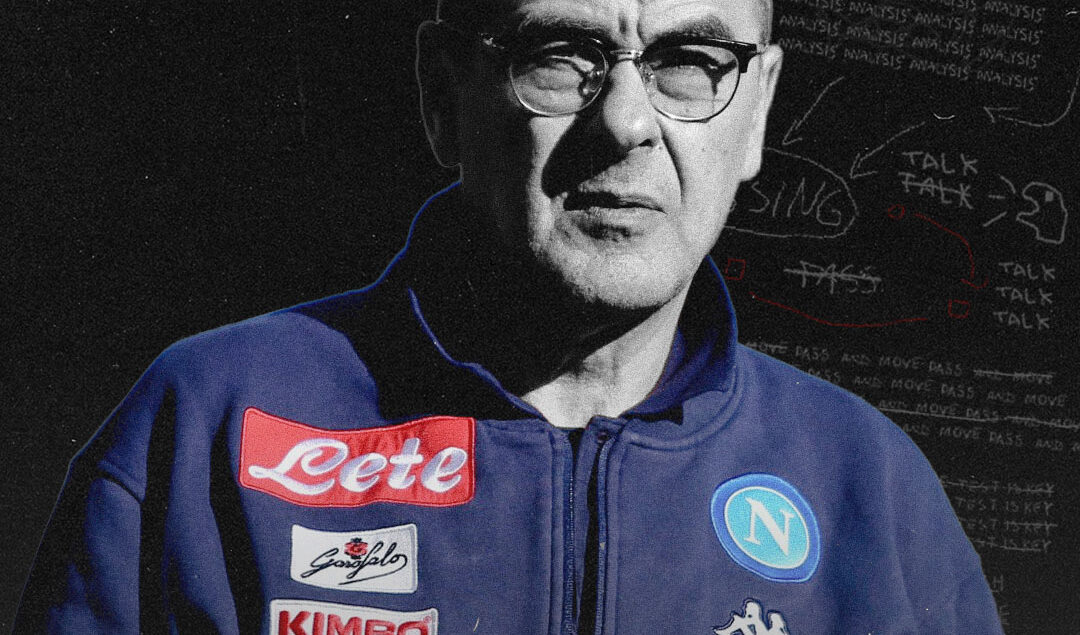Through the Looking Glass of Big Data: SSC Napoli 2015/16 and the Vindication of Maurizio Sarri: Part Three
Part III: Valentine’s Day heartbreakers and (quite a few) record-breakers
Fresh from their first “Winter Champions” title in the 21st century, Napoli strolled to five straight victories in the new year, led by six goals from Gonzalo Higuain, who had taken his record to 24 goals in as many games. Jose Callejon had also found his scoring touch to net four times over the same span, arriving from his wide-right position to get on the end of dangerous plays developed on the ever-creative left-sided attack. The club’s 100% record in January was marred only by crashing out of the Coppa Italia quarter finals in a 2-0 loss to Inter.
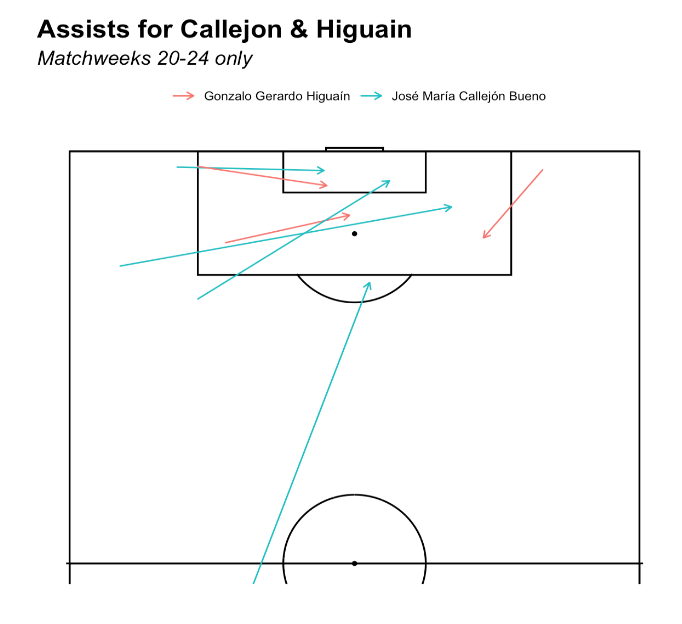
Juventus was able to keep pace, however, winning their five matches with aplomb as they failed to concede a single goal, and in match week 25 the two sides met in Turin the day before Valentine’s Day, February 13th, in what was billed as an early title decider. Max Allegri chose to line up his charges in his favored 4-4-2 on paper, but asked his team to defend in a 3-5-2, perhaps a calculated risk as Napoli had struggled to create against a back three in bore 0-0 draws against Carpi and Genoa earlier in the season.
Stephen Lichtsteiner, the more traditional right back, was deployed as a de-facto center back alongside Leonardo Bonucci and Andrea Barzagli with the pacy Colombian Juan Cuadrado tasked with dropping back to double-team Lorenzo Insigne and create a back five. Sarri, of course, lined up in his favored XI in the 4-3-3, perhaps an early sign that his side were suffering from the same predictability in system and personnel for which Rafa Benitez had received such criticism by the end of his reign.
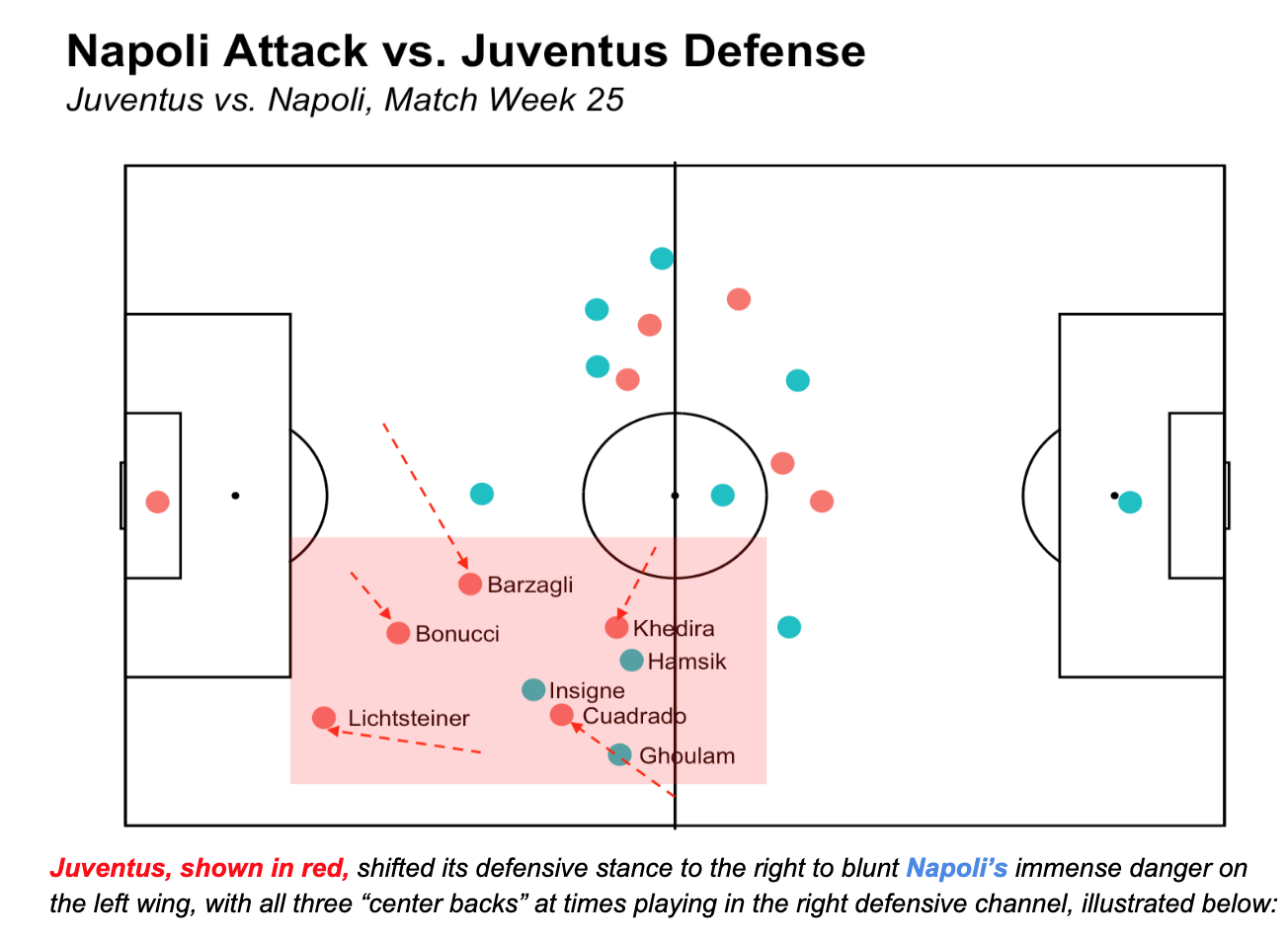

From the second half of the match between Napoli & Juventus, with black dotted lines showing the back five in rest defense as Cuadrado drops back to support Lichtsteiner.
The Juventus coach’s tactical selection was vindicated over the course of a match where Napoli struggled immensely to create chances. Bonucci and Barzagli played immensely well to deny Higuain the space to receive the ball, let alone turn and shoot, while the combination of “two” right backs in Lichtsteiner and Cuadrado managed to nullify Napoli’s potent left-sided creative threat. In fact, the Partenopei managed only one shot on target the entire match from the boot of Insigne, worth a measly 0.1 xG.

Aside from a clear chance for Dybala which the young Argentine skied over the bar, Juventus were also reduced mostly to shooting from distance, but it was ultimately a long-range left-footed howitzer courtesy of substitute Simone Zaza in the 88th minute that gave the Bianconeri a crucial win and took the title race out of Napoli’s hands with 13 games to go. Thus began Napoli’s worst stretch of form over the season.
A heavily rotated and highly profligate Azzurri side were beaten 2-1 on aggregate in the Europa League Round of 32 at the hands of Marcelino’s defensively stalwart Villarreal, continuing Napoli’s woes in European competition. In domestic action, a bitter draw 1-1 against AC Milan sandwiched between the two legs against Villarreal proved similarly frustrating. Despite firing off 19 shots, Napoli managed to get only four on frame, their only goal coming from a heavily-deflected, highly-speculative long range effort from Insigne in the first half.
Then followed a physical 1-1 draw against Fiorentina, where at least Pipita was able to find the back of the net to end a four-game dry spell across all competitions. The dense run of five fixtures in two weeks, together with Sarri’s inflexibility in personnel and high-octane style, had clearly taken a toll on the Napoli players, who looked leggy as the match wore on. Napoli were reduced to committing a series of fouls to try to control the tempo of the match as they were thoroughly out-shot for the first time all season; only the crossbar’s double denial of Nikola Kalinic and Cristian Tello secured the draw, as Fiorentina perhaps should have walked away with three points.
Napoli returned to form in March with wins over Chievo, Palermo and Genoa behind four further goals from the talismanic Higuain, but significant damage had already been done; Juventus, on the back of Gigi Buffon’s still-standing record of 10 consecutive clean sheets, had dispatched Inter, Atalanta, Sassuolo, and cross-town rivals Torino to rise three points clear of Napoli in the league table with eight matches remaining.
Following the spring international break, Napoli started April with a trip north to take on Udinese at the Friuli, a fixture in which I Partenopei had failed to garner victory since a 5-0 win in September 2007. Juventus had beaten Empoli 1-0 the day before to take a six-point lead in the title race and the pressure was immense, not helped by the fact that AC Milan loanee Gabriel was forced to start in goal with Pepe Reina ruled out due to a calf injury picked up in training.
Napoli’s performance was fraught with nerves, with Kalidou Koulibaly penalized for a clumsy tackle inside the box within fifteen minutes, and the spot kick was promptly converted by a 21-year-old Bruno Fernandes. Higuain’s club-record 30th league goal of the season offered some hope in the 24th minute, but the side gave away a second penalty two minutes later; though Gabriel was able to stave off Fernandes’ tame effort, Maurizio Sarri was sent to the stands for his vociferous remonstrations against the referees. Fernandes atoned for his miss with a spectacular overhead kick to retake the lead on the stroke of halftime, and Napoli went into the break down both a goal and a coach.
Napoli struggled to find its rhythm in a match that was marred by 38 total fouls and labored yet again to create chances in the second half against a well-organized back five, ultimately conceding a third on the hour mark before Gonzalo Higuain was shown a second yellow card for a late challenge on Felipe.

The Argentinian had to be held back by his teammates as he laid hands on the referee, for which he was suspended three matches, and the meltdown from Napoli’s talisman was emblematic of the side’s frustration as the ten men fell to a crushing 3-1 defeat.An incensed Sarri offered numerous complaints after the match, first taking issue with the early kick-off time.
“We didn’t move the ball the way we usually do and that has happened on the other occasions we have played at this time (12:30 pm),” he snapped at reporters in his post-game press conference. “It’s a difficult and unnatural time of day.”
“We have players who haven’t had a single training session after spending hours in the air,” he went on, alluding to the effects of the international break, especially for his South American players Higuain and Allan. “These are enormous difficulties and we are suffering more than the other teams.” Not noting, of course, that Juventus had five South American internationals of their own alongside Inter’s eight.
Despite Sarri’s rather petulant protestations, the match proved to be the death knell for Napoli’s title challenge; now six points back of a rampant Juventus that had gone 20-1-0 since the end of October, it seemed nigh impossible that Sarri could lead his charges back to the summit in the seven matches that remained, especially without their main goal-scoring threat.
Though the Azzurri bounced back with a 3-0 at the San Paolo over Hellas Verona without their star striker, their away form disintegrated. Bereft of the confidence and momentum that had propelled their title charge, a blunted Napoli sorely missed Gonzalo Higuain’s cutting edge in their next match away to Inter, falling 2-0 again to a Nerazzuri side that had knocked them out of the Coppa by the same scoreline in January.
Despite recovering again in a 6-0 home rout of Bologna, Napoli then succumbed to a limp 1-0 defeat to Roma in the capital despite welcoming Higuain back into the lineup. The result handed Juventus an unassailable 12 point lead with three matches remaining, mathematically sealing the Bianconeri’s fifth straight title.
Though the title had slipped away, Sarri’s men won their last three matches to earn their highest-ever Serie A points tally with 87 and confirmed their place in the 2016/17 UEFA Champions League group stage for the first time in 3 years, beating Roma to 2nd place with a 4-0 thrashing of already-relegated Frosinone on the final day.

“I thank the whole city for how they have welcomed me and I thank the fans, because we may have finished second but our fans are the champions of Italy,” beamed the native Neapolitan coach in his last press conference of the season. Sarri was recognized for his improbable title challenge with the Panchina d’Oro (“Golden Bench”) award for the best manager in Serie A, selected by the coaches themselves.
Flying slightly under the radar, Allan finished 3rd in the league for ball recoveries with 101 over the course of the season, behind only Marten De Roon (135) and Gaetano Letizia (103). However, Allan recorded the highest possession-adjusted ball recoveries, as De Roon’s Atalanta and Letizia’s relegated Carpi averaged a mere 47% and 35% of possession, respectively, compared to Napoli’s league-leading 65%.
Lorenzo Insigne was also one of the most threatening attacking players in the league with 12 goals and 9 assists, accumulating the fifth highest expected non-penalty expected goal contributions per 90 in the league overall, and the highest among non-strikers.
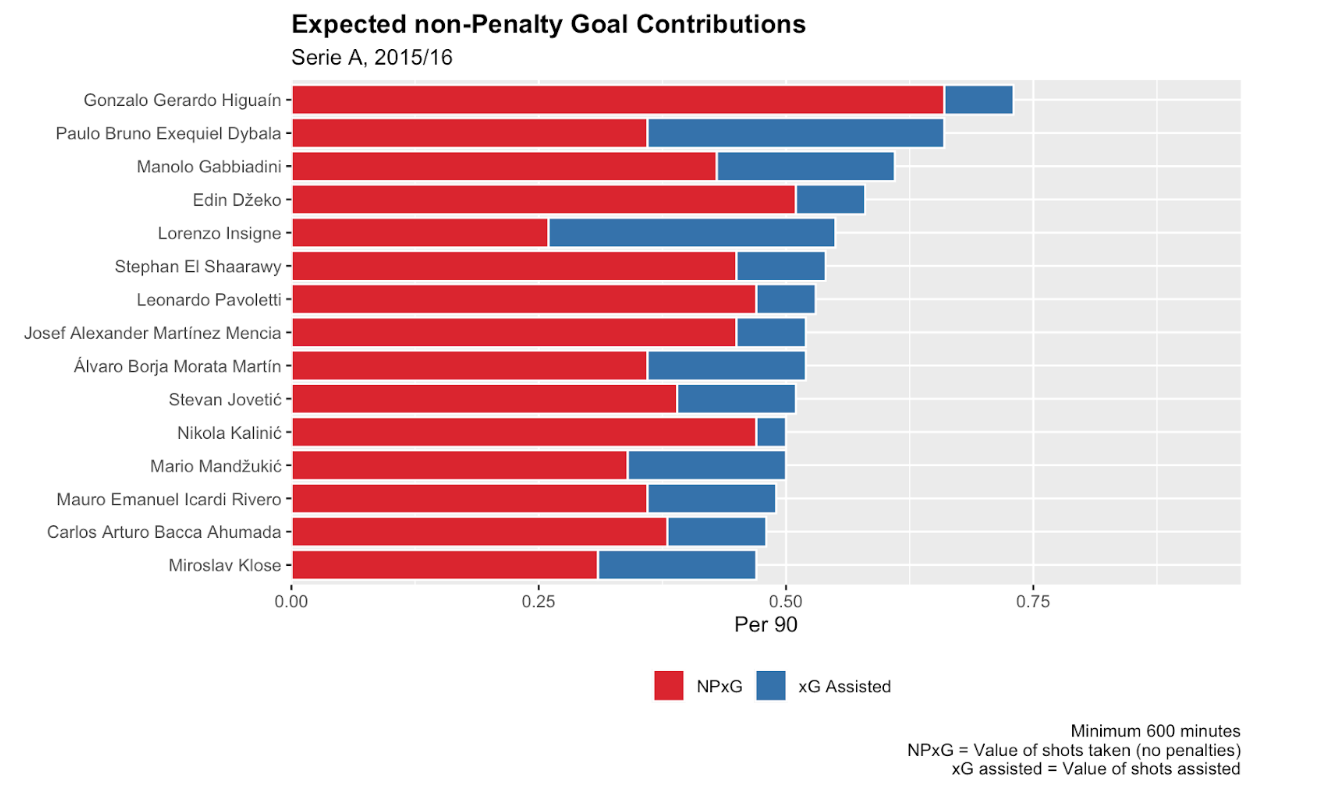
The plaudits remained focused, however, on Gonzalo Higuain, and rightfully so. El Pipita fired six goals in the last three match weeks, including a hattrick in the final match finished off a sensational bicycle kick, to complete a record season. The 28-year-old cantered to the Capocannoniere with 36 goals, 17 higher than 2nd-placed Paulo Dybala, breaking AC Milan hitman Gunnar Nordahl’s long-standing 35 goal record for a 38-game Serie A season from 1949/50.
Not only did he outperform the next highest striker in expected goal value by 10 (25 xG to Carlos Bacca’s 15), he outperformed his xG by +11, two times higher than the next most prolific attacker (a certain Mohammed Salah with +5.5), demonstrating his phenomenal finishing abilities.
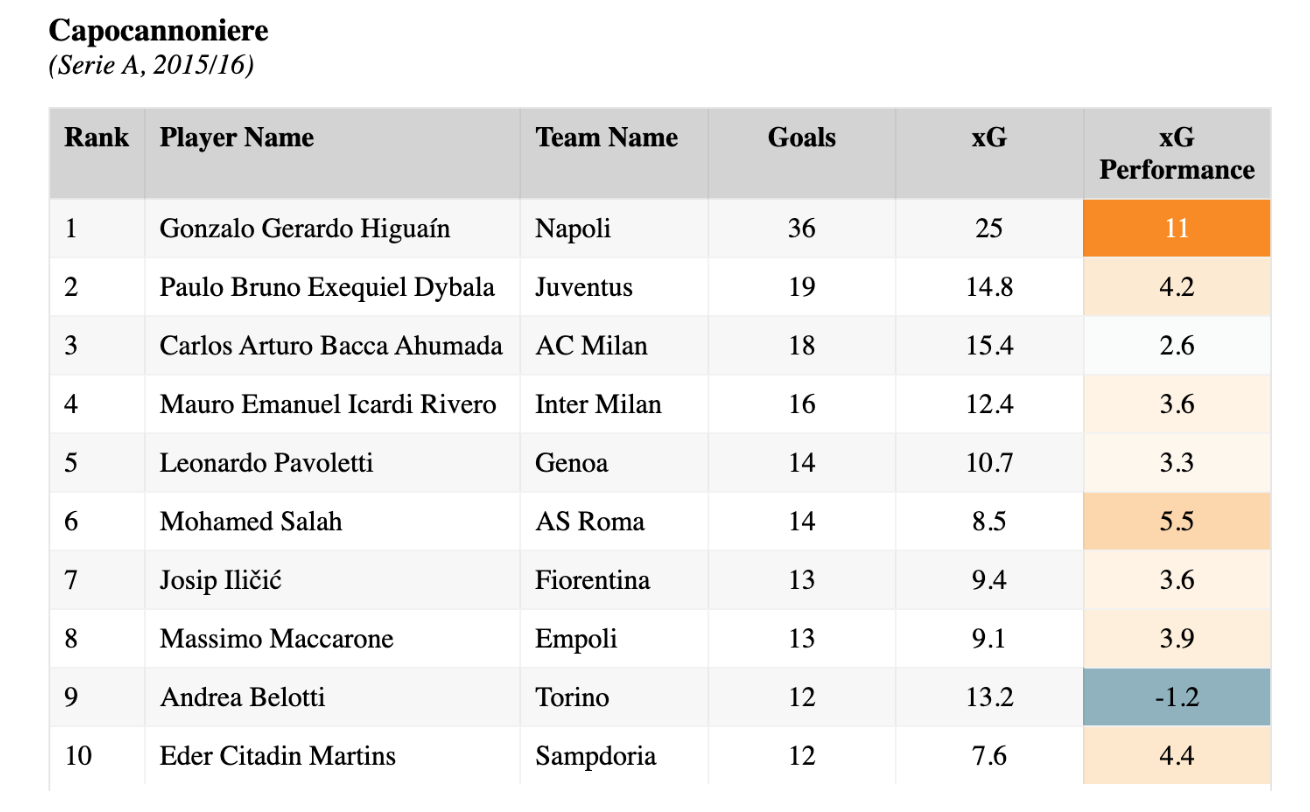
“I want to thank Maurizio Sarri,” an emotional Higuain told reporters after the final match, having run directly to celebrate with his coach after scoring his acrobatic third goal. “He has helped me so much, he always told me what I had to do to improve and I always listened.”
The fans had serenaded their record goalscorer with chants of, “Oh mamma, mamma, mamma…I’ve seen Higuain,” a song usually reserved for Diego Maradona and reportedly not heard in the San Paolo in over twenty years, and the significance was not lost on I Partenopei’s newest Argentinian hero. “This season I have felt the love,” Pipita went on. “I feel loved here more than I did at any other club I’ve been at.”
By July, however, the love affair was clearly over as archrivals Juventus met Higuain’s €90m release clause to bring the predatory poacher to Turin, at the time the most expensive transfer in Serie A history and the third-most expensive in the world, behind only Real Madrid’s acquisitions of Cristiano Ronaldo and Gareth Bale. Outraged Napoli fans, as they tend to do, burned their replica jerseys and labeled their bygone idol a “rotten dirty traitor”.
Though Higuain’s departure certainly cast a shadow over the summer of 2016, Sarri again showed his tactical ingenuity in the season to come. After Higuain’s €35M replacement Arkadiusz Milik went down with a long-term injury early in the season, Dries Mertens was converted into a central striker and thrived in the role, netting 28 times in the league, just one goal behind AS Roma’s eventual Capocannoniere winner Edin Dzeko.
Though Napoli could only muster a 3rd place finish, I Partenopei scored a league-high 94 goals, with 60 goals from the dynamic front three of Mertens, Insigne and Callejon alone. Much to the club’s chagrin, however, Higuain scored the winner in his first Serie A match against Napoli in October and scored three more in a 5-4 victory over the Azzurri in the two-legged Coppa Italia semi-final; Juventus, inevitably, would go on to win both competitions behind 27 goals in both competitions from their freshly minted Argentine, their fourth consecutive domestic double.
2017/18 was another record-breaking near-miss as Sarri’s men again challenged for the title and claimed their second unofficial Campione d’Invierno title at the halfway mark. However, Sarri became the first coach to twice lose the Scudetto from such a position as the side faltered in the second half of the season and went on to finish 2nd as Juventus stormed to their sixth straight title. Still, Sarri’s men broke the club’s record for most points for a second time in three years with 91, the highest-ever return for a team without winning the league and the fourth-highest points total overall in Serie A history.
Now a long-time admirer, Arrigo Sacchi was resplendent in his praise, calling Sarri’s Napoli “the most important thing seen in Italy in 20 years,” perhaps not-so-subtly referencing the revolutionary football of his own Milan side of the late 1990’s. By the end of 2017/18, however, Sarri was ready for a new chapter.
“You can’t say you’re ready to go again and try again when you don’t know that everyone will remain here,” he told journalists after the final game of the 2018 season on May 18th, a thinly veiled dig at De Laurentiis’ strategy in the transfer market. “I don’t know if the club will manage to keep the players who have release clauses when offers will come in from big clubs.”
The volcanic De Laurentiis, never one to take lightly to any slight, moved quickly and by the 23rd had announced that Carlo Ancelotti had been appointed as Sarri’s replacement, even before the old coach’s departure had been confirmed. Within a month, Chelsea announced Sarri as their new manager as the replacement for Antonio Conte, who, despite winning the league with a record 30 wins in 2017, had been sacked for leading the Blues to a just a 5th place finish in 2018 which failed to see the club qualify for the Champions League.
Asked about the appointment, De Laurentiis said simply, “We gave Sarri everything and in three years we didn’t win anything.” Not bitter at all.
Sarri had an up-and-down season at Chelsea, but went on to finish 3rd in the league and win the first major trophy of his professional career by defeating city rivals Arsenal 4-1 in the Europa League final, 28 years after beginning his coaching career. The look of near-disbelief on the prickly Italian’s face as he received his winner’s medal was a joy to behold.
More infamously, English football fans will certainly recall Chelsea’s loss in the League Cup final on penalties to Manchester City, which saw Kepa Arrizabelaga refuse to be substituted before the shootout as Sarri went utterly apoplectic on the touchline, though the duo later claimed it was all a “misunderstanding”.
Sarri left England after just one season and returned to Italy with Juventus, where he restored the by then out-of-favor Gonzalo Higuain to the lineup alongside a certain Cristiano Ronaldo as he led the Bianconeri to their ninth straight Serie A title, becoming the oldest coach in history to win the league at a ripe 61 years of age.
Perhaps fatefully, Sarri’s Juve were then defeated in the Coppa Italia final by his old side Napoli in a penalty shootout as I Partenopei claimed their first silverware since the Benitez era.
A Farewell to Luciano Spalletti, the Man Who Ended Napoli’s Scudetto Drought
Today, Sarri is back at work with Lazio (and coaching yet another former player in Elseid Hysaj), which he led to a surprise 2nd place finish in 2022/23. The Biancocelesti’s achievements, however, will be remembered as just a footnote in a historic season that saw Luciano Spalletti’s Napoli finish the job that Sarri had started to win their first Scudetto in over three decades.
It is Spalletti who rightly gets the credit, four years on from the Sarri era and with the core of the squad almost entirely turned over. Managing the emergence of Kvaratskhelia and Osimhen to fill the shoes of the freshly-departed Insigne and Mertens was no easy feat, nor was the replacement of the commanding Koulibaly with the hidden gem Kim Min-jae.
Sarri’s influence has lived on in the leadership of the team, though, as both vice-captain Mario Rui and Piotr Zielinski, by now seasoned veterans who played under Sarri at Empoli and were brought to Napoli by their old boss, were instrumental to Spalletti in the title run-in.
And, truth be told, none of it may have been possible without that initial spark from Mister 33. The unlikeliest of calcio heroes, a banker-turned-manager from the doldrums of the lower leagues that dared to challenge the most dominant Juventus team in Serie A history, the ideological proponent of a relentlessly creative attacking style that earned flowers from the greatest Italian tacticians of all time, and a dreamer and believer in the city he called home.
This one’s for you, Maurizio.
By: Neal Hasan / @_____neal_____
Featured Image: @GabFoligno / Marco Canoniero / LightRocket
